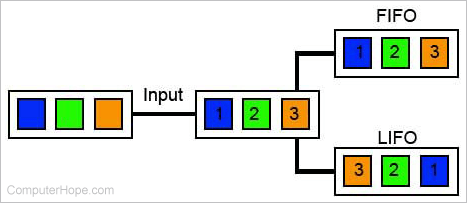LIFO
LIFO may refer to any of the following:
1. Short for last in, first out, LIFO is a method of processing data where the data last received is the first to be sent after processed. Below is an example of how FIFO (first in, first out) and LIFO would work. As you can see, with LIFO, the data is sent in the same order it was last received. So in this example, it is reversed.

In computer science
The LIFO is an important data structure used in computer science. For example, the stack data structure follows the LIFO principle. A stack starts with zero elements. When new elements are added or "pushed on" to the stack, a stack pointer is incremented to point at the new "top" element. When elements are retrieved from the stack, the top element (at the stack pointer index) is "popped off," removing it from the structure. Then, the stack pointer is decremented by 1 to point at the new top element.
Stacks have many uses in computer programming, such as expression evaluation, syntax parsing, recursive functions, and backtracking.
2. With a business, LIFO (last in, first out) is one method of handling inventory. With LIFO, when the merchant buys a good, it remains in the inventory until the same good already existing in the inventory is sold. Using LIFO instead of FIFO to manage inventory allows a company to report a lower inventory value because inflation costs on the exiting inventory are not considered. Because of the ability to misrepresent an inventory's actual value for tax purposes, some countries have banned LIFO and require businesses use FIFO.
Business terms, Computer abbreviations, Electronics terms, FIFO, Hardware terms
